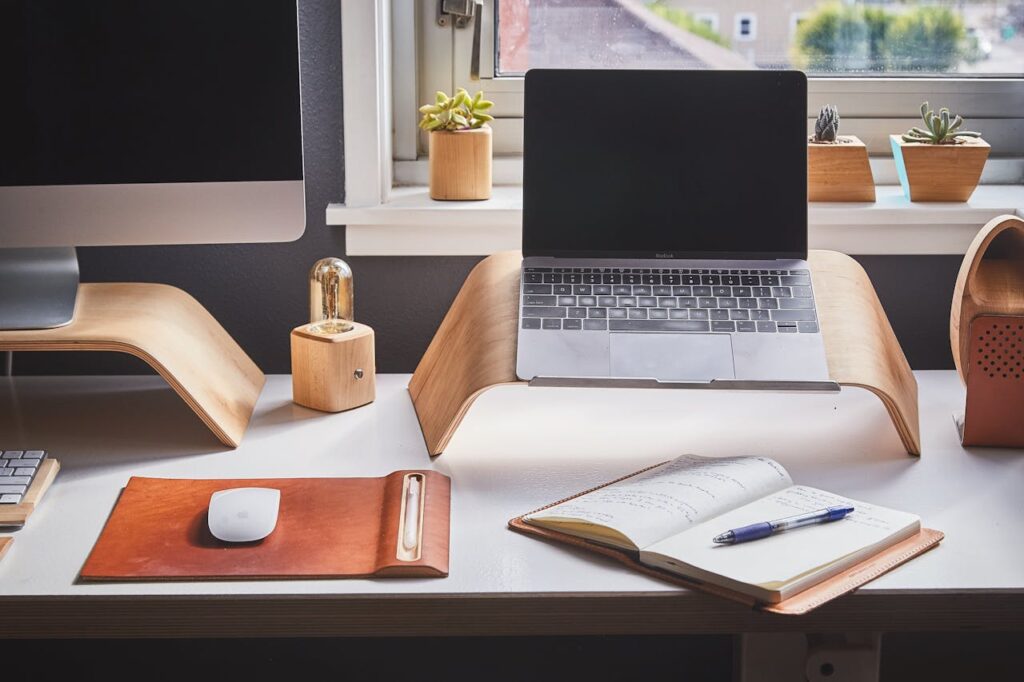If you work from home, whether full-time, or hybrid, you already know that productivity at home is a different ball game. Between wanting to stay comfy on the couch and nodding off to watching one last episode of your favorite show, getting stuff done can be a big challenge.

I’ve been working from home for 4 years now, and in that time I’ve learned what actually helps. The truth is, you don’t need a million hacks, you just need the right ones at the right time of day.
So I decided to split this into two posts. In this first one, we’ll talk about the habits that help you start your day strong and get focused quickly. In part two, we’ll cover the tips that keep your energy steady, help you stay consistent, and make it easier to actually clock out at the end of the day.
Let’s dive into part one:
Quick Skim
Toggle11 productivity tips that make your mornings smoother
1. Start with your “why” every day
When you work from home, the lines between home and work can become mixed up. You wake up, check your phone, scroll through emails, and next thing you know you’re in work mode without even deciding to be.
Or it could be the other way around – you wake up, get the kids out the door, decide to watch a tv show and then your brain remains in chill mode.
When you start your day like this, you end up not achieving much.
So instead here’s what to do: start your day with a simple why, Just ask yourself: “What’s one thing I need to accomplish today to feel like it was a good day?” That one small question can give your day direction. It doesn’t have to be a huge goal. Just something that makes you feel like your time meant something.
Once you have your answer, you can then ensure everything you do is leading you to that goal. Even if you entertain some distraction as the day goes on, with your goal in mind, even better if it’s written down, you’ll get back on track.
2. Plan your day before it begins
Without a commute, a boss walking past your desk or a 9am meeting to anchor your morning, it’s easy to drift. And then suddenly, it’s 2pm and you’re not sure what you’ve actually done.
It would make so much difference if you take 5 minutes — either the night before or right after breakfast — to write out your top 3 priorities. Simply ask yourself. “What are three time sensitive things I must do today?” This will help give your day shape. It works every time.
3. Don’t aim for 8 hours of deep work
At home, there’s a weird pressure to “prove” you’re working which often means trying to be productive for 8 straight hours. But our brains don’t work like that even in an office.
To be more productive, Instead of spreading your energy too thin, focus on 4–5 hours of real, focused work. That’s more than enough to get big things done and it’ll help you feel less drained by the end of the day.
4. Use theme days to simplify decisions
When everything is on your plate every day, it can be hard for your brain to decide where to start. And that mental load adds can be a source of stress.
One way to address this is to start setting theme days if possible: Mondays for meetings, Tuesdays for writing, Fridays for admin.
When you plan your week like this, you’ll spend less time deciding or switching between tasks, and more time doing.
5. Track your time for one week
We think we know where our time goes but the truth is, we often don’t. You may feel like you “worked all day” when in reality, you only had 3 hours of focused time.
When you wfh your time can be quietly and easily chipped away by things like:
- 6 back-and-forth emails that could’ve been a 10-minute call
- Social media breaks that turned into doom scrolling
- Switching between tasks too often and having to refocus
- Interruptions from kids, partners, or laundry
- Taking too long to start because you weren’t clear on what to do first
Here’s how tracking can help:
Let’s say on Monday you tracked your time and realized:
8:00–9:00 → Browsed emails + scrolled social media
9:00–10:00 → Half-finished a report while checking texts
10:00–11:00 → Focused writing time (felt amazing!)
11:00–12:30 → Got distracted by chores + calls
2:00–3:00 → Tried to work again, but got stuck and gave up
3:00–4:00 → Refocused and completed a full task
You might notice:
- Your best focus happens late morning
- Multitasking slows you down
- You lose momentum after long breaks
From there, you can adjust.
You might decide to:
- Protect 10–12 as your no-distraction work block
- Check email at 12:30 instead of first thing
- Save chores or admin for 3pm when your energy dips
Noticing your patterns and gently shifting your day will help you get more done with less stress. So try it out, just for a week, track how you’re spending your time, even loosely. Patterns will jump out. Then you can adjust it in a way that yields more output.
6. Create a dedicated workspace
If you’re working from the kitchen table one day and the couch the next, you might find it hard to focus. This is because your brain does better when it knows, “this is my work spot.”
Even if you don’t have a dedicated office room, just pick one area in your home that’s mostly for work. Add a little lamp, a small plant, or anything that makes the space feel calm and focused.
With such a dedicated space your brain will always know when it’s time to work.
That said, some days your space will still not cut it even after cleaning and organising. This is where a little change of scene can work wonders and the reason why people go to cafés: not for the coffee (okay, maybe a little), but because stepping out of your usual environment helps you reset.
So if you’re feeling stuck or distracted, try working from a quiet café or library for a few hours. You’ll often find that just being in a new space makes you sharper, faster, and more focused.
7. Keep your space clean-ish
When you work and live in the same space, clutter builds up without you even noticing. A coffee cup here, a pile of papers there, open tabs all over your screen: it all adds up.
That’s why it helps to build a tiny habit of resetting your space at the end of the day.
It doesn’t have to be a big clean-up. Just 5 minutes.
- Toss the empty snack wrappers
- Put pens back in a jar
- Wipe crumbs off your table
- Close all your tabs and documents
- Maybe even light a candle or turn on a soft lamp
This little ritual signals to your brain that the workday is done. It also makes it easier to start fresh tomorrow.
8. Work near natural light if you can
Working in a dark corner for “cosy aesthetics” can quietly drain you much more than you even realize. You might push through it, and enjoy the ambience but by lunchtime, you’re tired, sluggish, and finding it hard to concentrate.
It’s not just your mood that’s affected. Lack of light actually affects how alert and focused your brain feels.
That’s why natural light is such a game-changer when working from home.
If you can, set up your desk or table near a window. Open the blinds, crack the window, let the daylight in even if it’s cloudy.
And if you don’t have great window access, don’t worry. You can still add brightness with a daylight bulb or a small desk lamp with a warm glow.
By doing this, you’ll have a space that energizes you.
9. Sit somewhere that feels good for your body
It’s easy to ignore your setup when you’re working from home. You tell yourself, “I’ll just work from the couch for a bit,” or “The dining chair is fine.” But over time, those little choices affect how you feel — and how long you can focus.
Your body and brain are connected. If your back hurts or your neck’s strained, your energy drops and it’s harder to stay in flow.
So if you’re going to be working from home long-term, it’s worth getting a few things that help:
- A supportive chair
- A wireless mouse
- A laptop stand or a few books to raise your screen
It doesn’t have to be fancy — it just has to feel good to sit there for a few hours at a time.
10. Time-block your day
When your home is also your office, the hours tend to blur. You work “a little” in the morning, break in the afternoon, and before you know it, you’re back on at 9pm.
With time-blocking you get to set specific hours for work, breaks, and even chores. Once you start, you’ll notice it brings structure back into your day — and protects your personal time too.
11. Try the Pomodoro method
Pomodoro technique helps so many people stay productive whether at the office or at home. You set your timer for 25 minutes of work, 5-minute break.
This method is very popular because many people cannot stay focused for long periods of time. So the pomodoro technique teaches your brain to focus in short sprints. And those breaks will stop you from burning out by lunch.
Final Thought
Working from home can be empowering, flexible, and freeing — but only if you build the right habits around it. These 11 tips are all about getting your day started on the right foot so you feel clear, focused, and ready to go.
In Part Two, we’ll talk about what comes next: how to stay consistent, protect your energy, and (the hardest part of all) actually log off at the end of the day.






